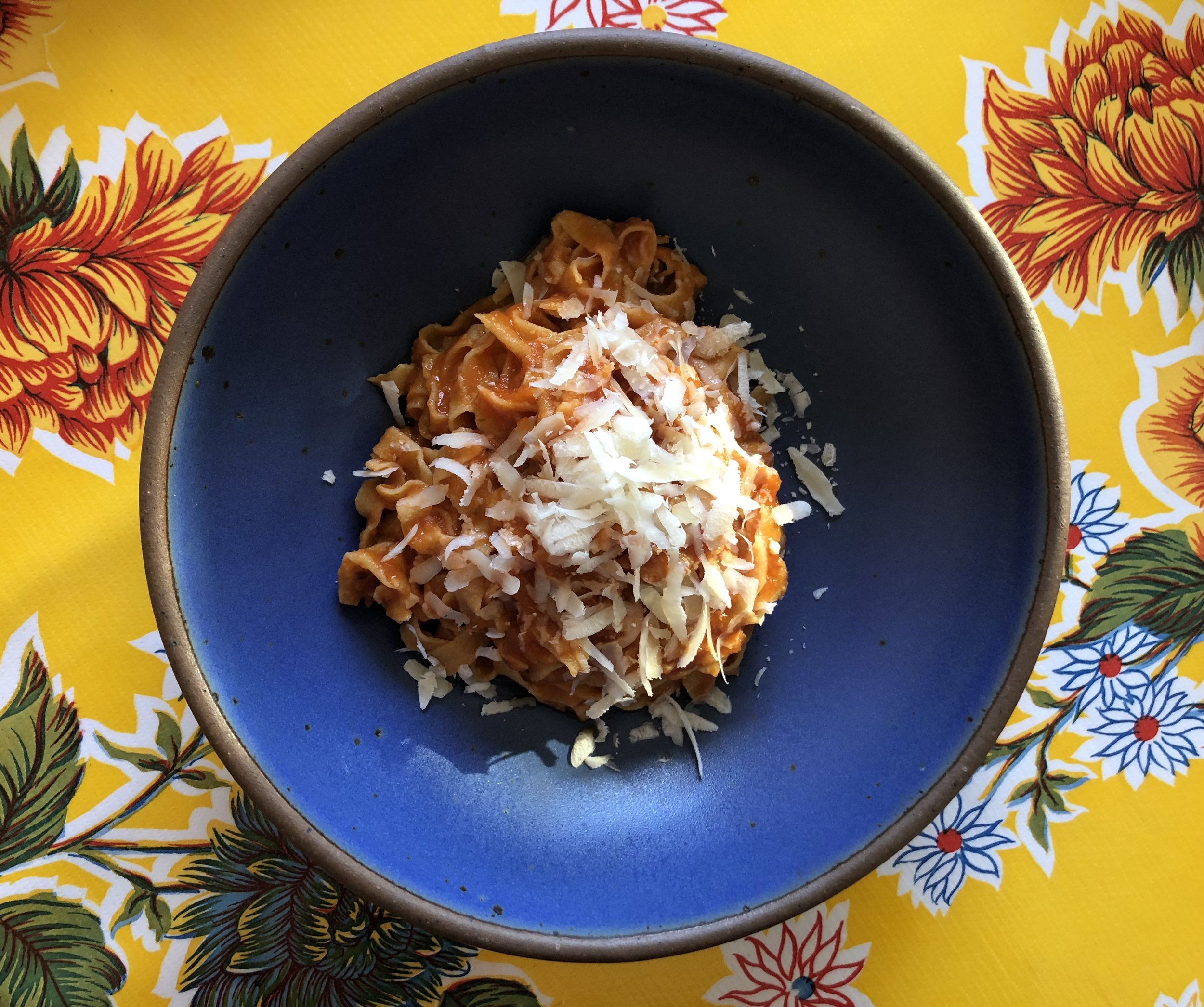Good morning!
I’ve slipped into the cozy outfit from yesterday, walked the dog, it’s not -6° outside anymore, and there’s a loaf of sourdough doing it’s thing in the oven. We made it through the first week of the year and I’ve managed to dip my toes back into work and homework, awakening and stretching those parts of myself that I’d allowed to rest for the last two weeks. All in all, I’m feeling quite good about the start of the year, tucked into my little kitchen with a cup of coffee, a grocery list, and another recipe to tell you about.
Pasta alla Pomarola is the quintessential “special sauce.” It’s not the special sauce you’re thinking of that goes on burgers; that lovely combination of mayonnaise, ketchup, relish, a dash of tabasco and Worcestershire (I like this recipe). What I’m referring to is the Italian red sauce that conjures checkered tablecloths and begs for meatballs and parm as a companion. The origin of Pasta alla Pomarola is somewhat mythic to me, as a bona fide Chez Panisse fangirl. Chez Panisse, the gorgeous Berkeley restaurant and café where Samin Nosrat got her start in a professional kitchen, is known for crafting a new menu every single day and letting the freshness, color, and texture of what’s in season guide their decisions in the kitchen. Years ago, while Nosrat was fairly new to working at the restaurant, Chez Panisse held a contest among all the staff to create the best tomato sauce with the only rule being that the contest entrants had to use ingredients from Chez Panisse’s kitchen. The prize was $500 and credit on the menu each time the sauce was used in perpetuity (wow!). While Nosrat used this anecdote to explain the importance of using high quality olive oil in one’s cooking, my takeaway was “Great, now I have an incredible tomato sauce in my arsenal forever!”
IMHO, and in Nosrat’s opinion too, what makes this sauce so good is the aforementioned olive oil that emulsifies with the stewed tomatoes right at the end of cooking. Some incredible magic takes place, binding the acidic tomatoes and bright basil to the fatty oil, which is blended together into a gorgeous red sauce that is a welcome base for any pizza night at home (we swear by Mark Bittman’s dough in this household) and the centerpiece of any bowl of pasta. This week I used the Pomarola sauce in a bowl of homemade pasta; layered it between ricotta, mozzarella, Parmesan and homemade noodles in a lasagna; and spooned it over warm yeasty dough for prosciutto, bell pepper, caramelized onion, and feta pizza. I’ve got a little sauce left, maybe I’ll toast some bread and make sourdough pizza bread with the leftover sauce and mozzarella!
If you’re reading this thinking, “Oh my god, I’m not sure my olive oil stands up to making a good sauce like this, and I don’t want to spend an arm-and-a-leg at one of those fancy olive oil stores,” Nosrat’s got you. She recommends the Kirkland Signature Organic Extra Virgin Olive Oil from Costco which you can buy a big bottle of without breaking the bank and use for most of your cooking. We buy a bottle every time we wander the aisles of Costco and it lasts us months. When in doubt, look for oils that are produced from 100% California or Italian olives, keep your olive oil out of heat and direct sunlight, and use it or lose it. As an FYI, Nosrat reminds us that olive oil goes bad within twelve to fourteen months of when it was produced, so don’t save that fancy bottle from the beautiful olive oil store in Georgetown (lol, Sandy), use it in your cooking. And decide how you plan on using it. If it’s central to building the flavor of your dish, as in a moist olive oil cake, use the good stuff. If it’s a cooking medium, say for pan frying, use the Costco stuff. And remember, taste as you go. If it smells like crayons or tastes a little off, it’s time for a new bottle.
Now I have two questions for you, dear readers. Do you have a go-to pasta sauce recipe you swear by? And what do you do with your leftover sauce? I’m stumped at dreaming beyond pizza, pasta, and lasagna and would love to know your thoughts.
A blue bowl with homemade pasta tossed in Pomarola sauce and topped with shaved Parmesan cheese.
